ধাতব শীট উৎপাদনের জগতে দক্ষতা এবং নির্ভুলতা বিভিন্ন শিল্পের চাহিদা পূরণের মূল কারণ। রোল ফর্মিং প্রযুক্তি দীর্ঘদিন ধরে ধাতব শীটগুলিকে নির্দিষ্ট প্রোফাইলে গঠনের জন্য জনপ্রিয় পছন্দ ছিল, কিন্তু এই ক্ষেত্রে অগ্রগতি ঘটেছে ডবল লেয়ার রোল তৈরির মেশিনযা আরও বেশি সক্ষমতা এবং নমনীয়তা প্রদান করে। এই নিবন্ধে আমরা ডাবল লেয়ার রোল ফর্মিং মেশিনের ধারণা, এর সুবিধা, কার্যপ্রণালী, প্রয়োগ এবং মেশিন নির্বাচনের কারণগুলি অন্বেষণ করব। তাহলে চলুন শুরু করি!
ভূমিকা
ধাতব শীট উৎপাদন নির্মাণ, অটোমোটিভ এবং যন্ত্রপাতি উৎপাদনের মতো শিল্পে গুরুত্বপূর্ণ ভূমিকা পালন করে। রোল ফর্মিং, যেখানে ধাতব শীটগুলি ক্রমান্বয়ে কাঙ্ক্ষিত প্রোফাইলে গঠিত হয়, বহু বছর ধরে একটি জনপ্রিয় পদ্ধতি। তবে ঐতিহ্যগত রোল ফর্মিং মেশিনগুলি একবারে একটি প্রোফাইল উৎপাদনে সীমাবদ্ধ, যা সময়সাপেক্ষ উৎপাদন চক্র সৃষ্টি করে। এখানেই ডাবল লেয়ার রোল ফর্মিং মেশিনগুলি ভূমিকা পালন করে।
রোল ফর্মিং বোঝা
ডাবল লেয়ার রোল ফর্মিং মেশিনের বিশদ আলোচনা করার আগে, রোল ফর্মিংয়ের মূলনীতি বোঝা জরুরি। রোল ফর্মিং হলো একটি অবিরত প্রক্রিয়া যেখানে একটি সমতল ধাতব স্ট্রিপ একাধিক রোলার ডাইয়ের মধ্য দিয়ে পাস করা হয়, ধীরে ধীরে এটিকে কাঙ্ক্ষিত আকারে বাঁকানো এবং গঠন করা হয়। এই প্রক্রিয়া উচ্চ নির্ভুলতা এবং পুনরাবৃত্তিযোগ্যতা প্রদান করে, যা ব্যাপক উৎপাদনের জন্য আদর্শ।
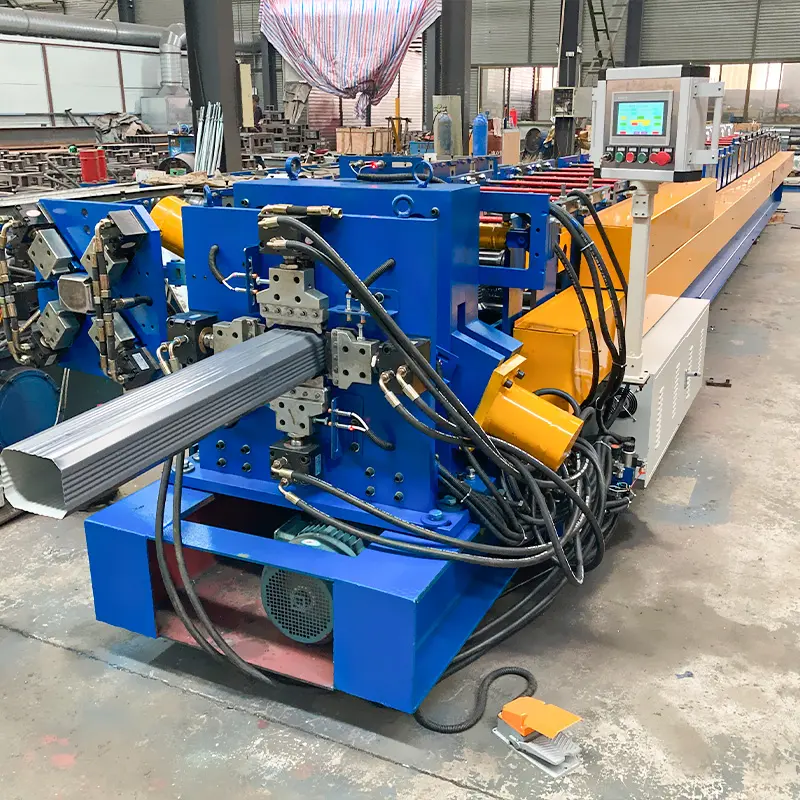
ডাবল লেয়ার রোল ফর্মিং মেশিনের প্রয়োজনীয়তা
ঐতিহ্যগত রোল ফর্মিং মেশিনগুলি শিল্পকে ভালোভাবে সেবা দিয়েছে যদিও, বাড়তি দক্ষতা এবং উৎপাদনশীলতার চাহিদা এই প্রযুক্তির সীমা প্রসারিত করেছে। ডাবল লেয়ার রোল ফর্মিং মেশিনগুলি দুটি ভিন্ন প্রোফাইল একসাথে উৎপাদনের ক্ষমতার কারণে জনপ্রিয়তা অর্জন করেছে। দুটি সেট রোলার ডাই ব্যবহার করে এই মেশিনগুলি উৎপাদন সময় অর্ধেকে কমিয়ে দেয় যখন গঠিত প্রোফাইলের গুণমান এবং নির্ভুলতা অটুট রাখে।
ডাবল লেয়ার রোল ফর্মিং মেশিনের সুবিধাসমূহ
ডাবল লেয়ার রোল ফর্মিং মেশিনগুলি সিঙ্গেল-লেয়ার সমকক্ষের তুলনায় বিভিন্ন সুবিধা প্রদান করে। কয়েকটি মূল সুবিধা নিয়ে বিস্তারিত আলোচনা করা যাক:
উন্নত দক্ষতা
দুটি প্রোফাইল একসাথে উৎপাদন করে ডাবল লেয়ার রোল ফর্মিং মেশিনগুলি উৎপাদন দক্ষতা উল্লেখযোগ্যভাবে বাড়ায়। এর ফলে লিড টাইম কমে, শ্রম খরচ হ্রাস পায় এবং সামগ্রিক আউটপুট বৃদ্ধি পায়।
খরচ সাশ্রয়
উৎপাদন সময় এবং শ্রম খরচ কমে যাওয়ায় ডাবল লেয়ার রোল ফর্মিং মেশিন ব্যবহারে উল্লেখযোগ্য খরচ সাশ্রয় সম্ভব। উচ্চতর আউটপুট এবং উন্নত দক্ষতা আরও লাভজনক কার্যক্রম নিশ্চিত করে।
বহুমুখিতা
ডাবল লেয়ার রোল ফর্মিং মেশিনগুলি বিভিন্ন শিল্পের চাহিদা পূরণের জন্য বিস্তৃত প্রোফাইল উৎপাদনের নমনীয়তা প্রদান করে। এই বহুমুখিতা একাধিক পণ্য লাইন নিয়ে কাজকরা প্রস্তুতকারকদের জন্য এগুলিকে চমৎকার পছন্দ করে তোলে।
স্থান অপ্টিমাইজেশন
ডাবল লেয়ার রোল ফর্মিং মেশিনগুলি একই মেশিনের মধ্যে দুটি প্রোফাইল উৎপাদন করে বলে দুটি পৃথক মেশিন চালানোর তুলনায় অনেক কম মেঝে জায়গা প্রয়োজন হয়। এতে প্রস্তুতকারকরা তাদের কর্মক্ষেত্র অপ্টিমাইজ করতে পারেন এবং উৎপাদনশীলতা সর্বোচ্চ পর্যায়ে নিয়ে যেতে পারেন।
গুণমানের উন্নতি
ডাবল লেয়ার রোল ফর্মিং মেশিনগুলির সুনির্দিষ্ট নিয়ন্ত্রণ এবং নির্ভুলতা সামঞ্জস্যপূর্ণ এবং উচ্চমানের প্রোফাইল নিশ্চিত করে। এটি কঠোর শিল্প মানদণ্ড পূরণ এবং গ্রাহকের প্রত্যাশা অনুযায়ী পণ্য সরবরাহের জন্য অপরিহার্য।
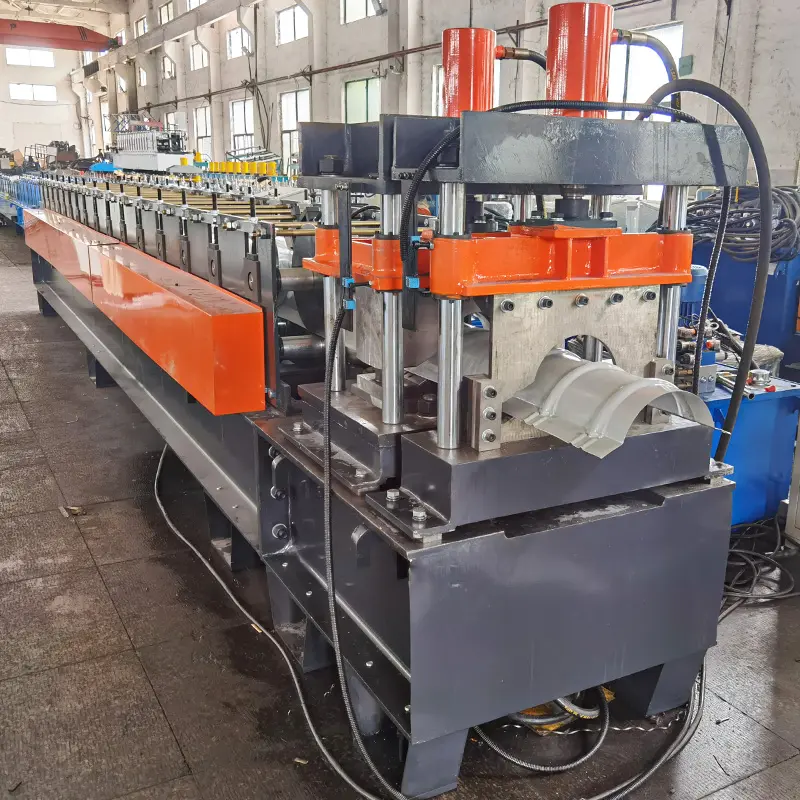
ডাবল লেয়ার রোল ফর্মিং মেশিনের উপাদান এবং কার্যপ্রণালী
ডাবল লেয়ার রোল ফর্মিং মেশিনের অভ্যন্তরীণ কার্যপ্রণালী সম্পূর্ণরূপে বোঝার জন্য এর মূল উপাদানগুলি এবং এর পিছনে থাকা কার্যপ্রণালী বুঝা জরুরি।
ফিডিং সিস্টেম
ফিডিং সিস্টেমটি ধাতুর স্ট্রিপ মেশিনে অবিরত সরবরাহের জন্য দায়ী। এতে সাধারণত একটি ডিকয়লার, স্ট্রেইটনিং ইউনিট এবং একটি ফিডিং রোলার সিস্টেম থাকে যা মসৃণ উপাদান প্রবাহ নিশ্চিত করে।
রোলার ডাই
যেকোনো রোল ফর্মিং মেশিনের হৃদয়স্থান হলো এর রোলার ডাই। ডাবল লেয়ার রোল ফর্মিং মেশিনের ক্ষেত্রে দুটি সেট রোলার ডাই পাশাপাশি সাজানো থাকে। প্রতিটি সেট একটি নির্দিষ্ট প্রোফাইল আকার দেওয়ার জন্য ডিজাইন করা হয় এবং ধাতুর স্ট্রিপ দুটি সেটের মধ্য দিয়ে একই সঙ্গে অতিক্রম করে।
ফর্মিং স্টেশন
ফর্মিং স্টেশনগুলি হলো সেই ধারাবাহিক রোলারগুলির সিরিজ যার মধ্য দিয়ে ধাতুর স্ট্রিপ অতিক্রম করে ধীরে ধীরে কাঙ্ক্ষিত প্রোফাইলে রূপান্তরিত হয়। ফর্মিং স্টেশনের সংখ্যা এবং বিন্যাস উৎপাদিত প্রোফাইলের জটিলতার উপর নির্ভর করে।
কাটিং প্রক্রিয়া
ধাতুর স্ট্রিপ কাঙ্ক্ষিত প্রোফাইলে আকার পাওয়ার পর, একটি কাটিং প্রক্রিয়া ব্যবহার করে এগুলিকে অবশিষ্ট স্ট্রিপ থেকে আলাদা করা হয়। বিভিন্ন কাটিং পদ্ধতি ব্যবহার করা যায়, যেমন হাইড্রোলিক শিয়ারিং, ফ্লাইং কাটঅফ বা পোস্ট-কাট পাঞ্চিং।
নিয়ন্ত্রণ ব্যবস্থা
আধুনিক ডাবল লেয়ার রোল ফর্মিং মেশিনগুলিতে উন্নত নিয়ন্ত্রণ সিস্টেম রয়েছে যা অপারেটরদের রোলারের অবস্থান, কাটিং দৈর্ঘ্য এবং গতির মতো বিভিন্ন প্যারামিটার সামঞ্জস্য করতে সক্ষম করে। এই সিস্টেমগুলি সুনির্দিষ্ট এবং সামঞ্জস্যপূর্ণ উৎপাদন নিশ্চিত করে।
ডাবল লেয়ার রোল ফর্মিং মেশিনের কার্যপ্রণালীতে ধাতুর স্ট্রিপের অবিরত ফিডিং জড়িত, যা রোলার ডাই এবং ফর্মিং স্টেশনের মধ্য দিয়ে অতিক্রম করে। স্ট্রিপ সামনে এগোতে এগোতে দুটি ভিন্ন প্রোফাইলে একই সঙ্গে আকার পায়। অবশেষে, প্রোফাইলগুলি কাঙ্ক্ষিত দৈর্ঘ্যে কাটা হয় এবং আরও প্রক্রিয়াকরণ বা প্যাকেজিংয়ের জন্য সংগ্রহ করা হয়।
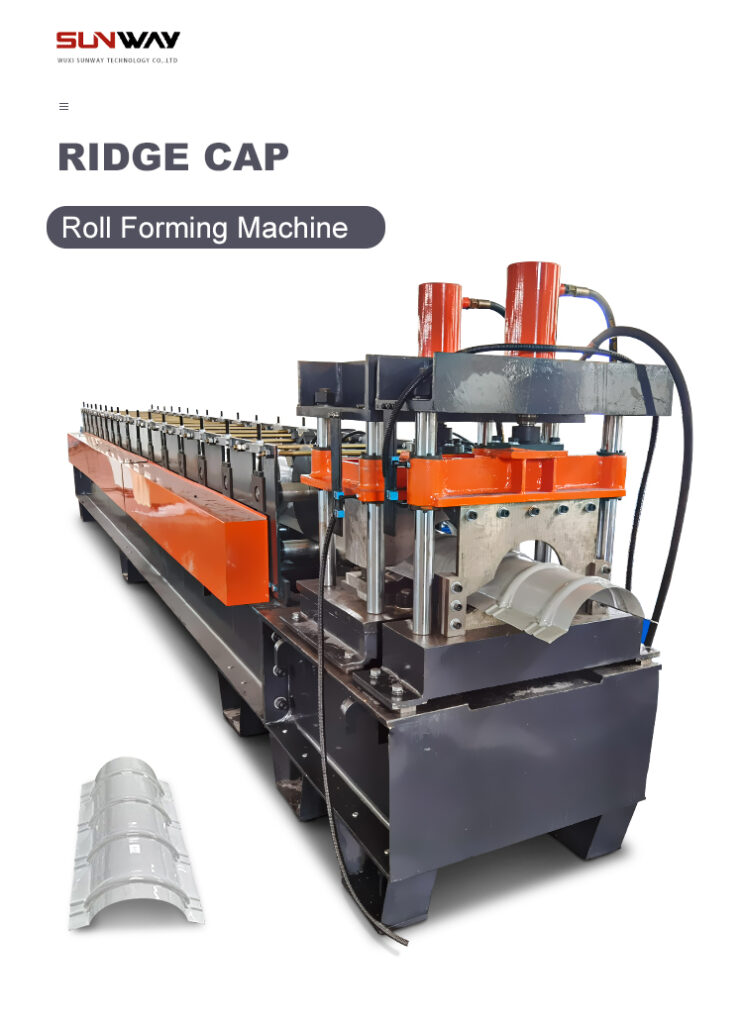
দ্বিস্তরীয় রোল ফর্মিং মেশিনের প্রয়োগসমূহ
দ্বিস্তরীয় রোল ফর্মিং মেশিনের বহুমুখিতা একাধিক শিল্পে বিস্তৃত প্রয়োগের পথ উন্মোচন করে। কিছু সাধারণ প্রয়োগের মধ্যে রয়েছে:
নির্মাণ ও ভবন নির্মাণ
ডাবল লেয়ার রোল ফর্মিং মেশিনগুলি নির্মাণ শিল্পে ছাদের শিট, দেয়ালের কভারিং এবং ছাদের প্যানেলের মতো প্রোফাইল তৈরিতে ব্যাপকভাবে ব্যবহৃত হয়। একাধিক প্রোফাইল দক্ষতার সাথে উৎপাদনের ক্ষমতা তাদের বিভিন্ন স্কেলের নির্মাণ প্রকল্পের জন্য আদর্শ করে তোলে।
অটোমোটিভ
অটোমোটিভ শিল্পে ডাবল লেয়ার রোল ফর্মিং মেশিনগুলি গাড়ির শরীরের প্যানেল, দরজার ফ্রেম এবং ছাদের রেলের মতো উপাদান তৈরির জন্য ব্যবহৃত হয়। এই মেশিনগুলির উচ্চ নির্ভুলতা এবং গুণমান অটোমোটিভ অংশসমূহের কাঠামোগত অখণ্ডতা নিশ্চিত করে।
গৃহস্থালি যন্ত্রপাতি উৎপাদন
ফ্রিজ থেকে ওয়াশিং মেশিন পর্যন্ত, গৃহস্থালি যন্ত্রপাতি উৎপাদন শিল্প ডাবল লেয়ার রোল ফর্মিং মেশিনগুলির উপর নির্ভর করে ধাতু শীটগুলিকে বাইরের প্যানেল, দরজার ফ্রেম এবং হ্যান্ডেলের মতো উপাদানে রূপান্তরিত করতে। একসঙ্গে একাধিক প্রোফাইল উৎপাদনের ক্ষমতা উৎপাদন প্রক্রিয়ার সামগ্রিক দক্ষতা বৃদ্ধি করে।
শেল্ফিং এবং র্যাকিং সিস্টেম
ডাবল লেয়ার রোল ফর্মিং মেশিনগুলি গুদাম, খুচরা দোকান এবং লজিস্টিক কেন্দ্রের জন্য শেল্ফিং এবং র্যাকিং সিস্টেম উৎপাদনে ব্যাপকভাবে ব্যবহৃত হয়। এই মেশিনগুলি বিভিন্ন দৈর্ঘ্য, আকার এবং লোড-বহন ক্ষমতাসহ প্রোফাইল দক্ষতার সাথে উৎপাদন করতে পারে, যা নির্দিষ্ট সংরক্ষণের প্রয়োজনীয়তা পূরণ করে।
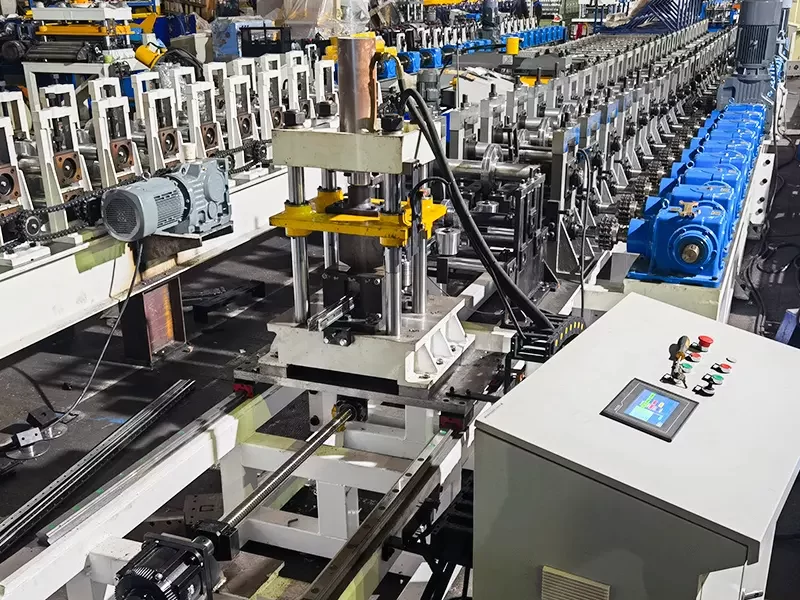
ডাবল লেয়ার রোল ফর্মিং মেশিন নির্বাচনের সময় বিবেচ্য উপাদানসমূহ
আপনার উৎপাদন প্রয়োজনীয়তার জন্য ডাবল লেয়ার রোল ফর্মিং মেশিন নির্বাচন করার সময়, সর্বোত্তম উপযোগিতা নিশ্চিত করতে বিভিন্ন উপাদান বিবেচনা করা অত্যাবশ্যক। কিছু মূল বিবেচ্য বিষয় হলো:
উৎপাদন ক্ষমতা
আউটপুট ভলিউম এবং গতির দিক থেকে আপনার উৎপাদন প্রয়োজনীয়তা মূল্যায়ন করুন। বটলনেক এবং বিলম্ব এড়াতে আপনার কাঙ্ক্ষিত উৎপাদন ক্ষমতা পূরণ বা অতিক্রম করতে সক্ষম একটি ডাবল লেয়ার রোল ফর্মিং মেশিন নির্বাচন করুন।
প্রোফাইলের জটিলতা
আপনার উৎপাদন করতে হবে এমন প্রোফাইলের ধরন বিবেচনা করুন। কিছু মেশিন সরল প্রোফাইলের জন্য উপযুক্ত হতে পারে, যেখানে অন্যরা আরও জটিল আকার এবং ডিজাইন পরিচালনা করতে পারে। নিশ্চিত করুন যে আপনার প্রয়োজিত নির্দিষ্ট প্রোফাইলগুলি মেশিনটি সমর্থন করতে পারে।
উপাদান সামঞ্জস্যতা
বিভিন্ন ডাবল লেয়ার রোল ফর্মিং মেশিনের কার্যকরভাবে আকার দেওয়ার জন্য উপযুক্ত উপাদানের ধরনের সীমাবদ্ধতা থাকতে পারে। নিশ্চিত করুন যে আপনার কাজের নির্দিষ্ট ধাতু উপাদান যেমন স্টিল, অ্যালুমিনিয়াম বা কপারের সাথে মেশিনটি সামঞ্জস্যপূর্ণ।
কাস্টমাইজেশন অপশন
যদি আপনার উৎপাদনে ঘন ঘন প্রোফাইল পরিবর্তন বা কাস্টমাইজেশন প্রয়োজন হয়, তাহলে দ্রুত এবং সহজ টুলিং পরিবর্তন সুবিধা প্রদানকারী একটি মেশিন নির্বাচন করুন। এটি ডাউনটাইম কমিয়ে সামগ্রিক দক্ষতা বাড়াবে।
মেশিনের স্থায়িত্ব এবং নির্ভরযোগ্যতা
দীর্ঘমেয়াদী উৎপাদনশীলতার জন্য নির্ভরযোগ্য এবং স্থায়ী মেশিনে বিনিয়োগ করা অত্যাবশ্যক। অবিরত উৎপাদনের চাহিদা সহ্য করতে সক্ষম উচ্চমানের উপাদান এবং উপাদান দিয়ে নির্মিত মেশিনগুলি খুঁজুন।
নিরাপত্তা বৈশিষ্ট্যসমূহ
অপারেটরদের সুরক্ষা এবং দুর্ঘটনা প্রতিরোধের জন্য ডাবল লেয়ার রোল ফর্মিং মেশিনটি সঠিক নিরাপত্তা বৈশিষ্ট্যসহ সজ্জিত নিশ্চিত করুন। জরুরি স্টপ, নিরাপত্তা গার্ড এবং ওভারলোড সুরক্ষার মতো নিরাপত্তা প্রক্রিয়াগুলি থাকা উচিত।
বিক্রয়োত্তর সহায়তা এবং পরিষেবা
ব্যাপক অ্যাফটার-সেলস সাপোর্ট প্রদানকারী একজন নির্ভরযোগ্য প্রস্তুতকারক বা সরবরাহকারী নির্বাচন করুন, যার মধ্যে রক্ষণাবেক্ষণ পরিষেবা, স্পেয়ার পার্টসের উপলব্ধতা এবং প্রযুক্তিগত সহায়তা অন্তর্ভুক্ত। এটি কোনো সমস্যার ক্ষেত্রে মসৃণ অপারেশন এবং ডাউনটাইম কমায়।
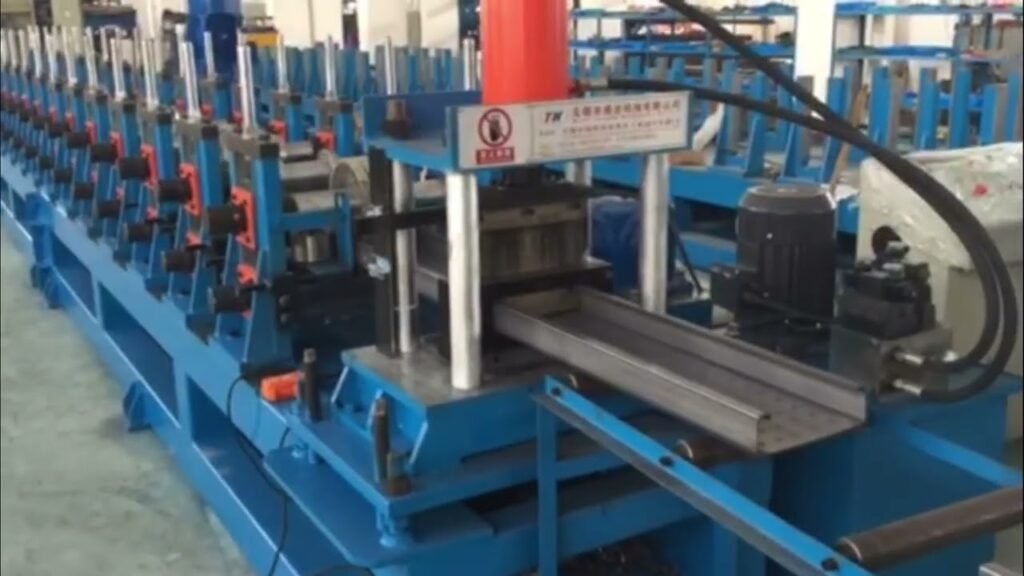
ডাবল লেয়ার রোল ফর্মিং মেশিনের রক্ষণাবেক্ষণ এবং যত্ন
আপনার ডাবল লেয়ার রোল ফর্মিং মেশিনের সর্বোত্তম কর্মক্ষমতা এবং দীর্ঘায়ু বজায় রাখতে নিয়মিত রক্ষণাবেক্ষণ এবং যত্ন অপরিহার্য। এখানে কিছু রক্ষণাবেক্ষণ টিপস মনে রাখুন:
পরিষ্কারণ এবং তৈলাক্তকরণ
নিয়মিতভাবে মেশিনটি পরিষ্কার করুন যাতে অপারেশনের সময় জমা হওয়া ময়লা, ধুলোবালি বা ধাতুর ছুরি অপসারণ করা যায়। এছাড়া, ঘর্ষণ কমানো এবং অকালে ক্ষয় রোধ করার জন্য চলমান অংশগুলির সঠিক তৈলাক্তকরণ নিশ্চিত করুন।
পরিদর্শন এবং সমন্বয়
মেশিনের উপাদানগুলির নিয়মিত পরিদর্শন করুন, যার মধ্যে রোলার ডাই, ফর্মিং স্টেশন এবং কাটিং প্রক্রিয়া অন্তর্ভুক্ত। ক্ষতি, অসমানভাব বা অতিরিক্ত ক্ষয়ের কোনো লক্ষণ পরীক্ষা করুন। প্রয়োজন অনুসারে সমন্বয় বা প্রতিস্থাপন করুন।
ক্যালিব্রেশন এবং সারিবদ্ধকরণ
সঠিক প্রোফাইল আকৃতি নিশ্চিত করার জন্য মেশিনের সঠিক ক্যালিব্রেশন এবং সারিবদ্ধকরণ বজায় রাখুন। রোলারের অবস্থান, কাটিং দৈর্ঘ্য এবং অন্যান্য প্রাসঙ্গিক প্যারামিটার পরীক্ষা করে সমন্বয় করুন যাতে কাঙ্ক্ষিত ফলাফল অর্জিত হয়।
অপারেটর প্রশিক্ষণ
মেশিন অপারেটরদের জন্য ব্যাপক প্রশিক্ষণ প্রদান করুন যাতে তারা সঠিক অপারেশন এবং রক্ষণাবেক্ষণ পদ্ধতি বুঝতে পারে। প্রশিক্ষিত অপারেটরদের সঠিক হ্যান্ডলিং এবং যত্ন মেশিনের আয়ুকে উল্লেখযোগ্যভাবে বাড়াতে পারে।
ডকুমেন্টেশন এবং রেকর্ড
রক্ষণাবেক্ষণ কার্যকলাপের বিস্তারিত রেকর্ড রাখুন, যার মধ্যে পরিষ্কারণ তালিকা, তৈলাক্তকরণ রুটিন, পরিদর্শন এবং যেকোনো মেরামত বা সমন্বয় অন্তর্ভুক্ত। এই ডকুমেন্টেশন মেশিনের পারফরম্যান্স ট্র্যাক করতে এবং পুনরাবৃত্তিমূলক সমস্যা চিহ্নিত করতে সাহায্য করবে।
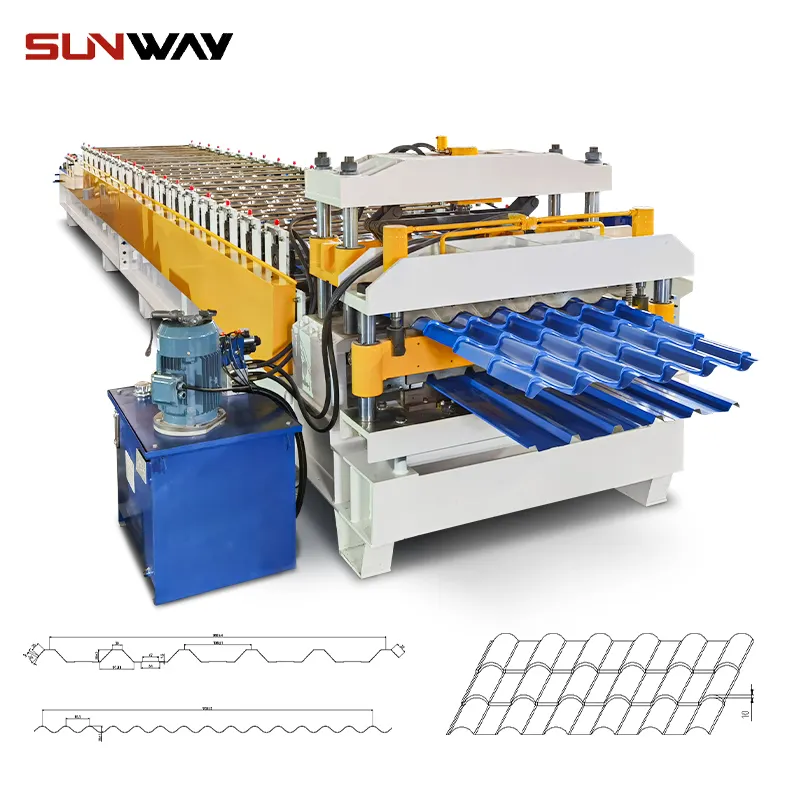
ডাবল লেয়ার রোল ফর্মিং প্রযুক্তির ভবিষ্যৎ উন্নয়ন
প্রযুক্তির অগ্রগতির সাথে সাথে ডাবল লেয়ার রোল ফর্মিং ক্ষেত্রও উদ্ভাবন থেকে মুক্ত নয়। এখানে কিছু সম্ভাব্য ভবিষ্যৎ উন্নয়ন উল্লেখ করা হলো:
উন্নত অটোমেশন
অটোমেশন উৎপাদন প্রক্রিয়া স্ট্রিমলাইন করতে গুরুত্বপূর্ণ ভূমিকা পালন করে। ভবিষ্যতের ডাবল লেয়ার রোল ফর্মিং মেশিনগুলি উন্নত রোবটিক্স, কৃত্রিম বুদ্ধিমত্তা এবং মেশিন লার্নিং অ্যালগরিদম অন্তর্ভুক্ত করতে পারে যা দক্ষতা অপ্টিমাইজ করবে, ম্যানুয়াল হস্তক্ষেপ কমাবে এবং সামগ্রিক নির্ভুলতা উন্নত করবে।
আইওটির সাথে একীকরণ
ইন্টারনেট অফ থিংস (আইওটি) উৎপাদন অপারেশনকে বিপ্লবীভাবে পরিবর্তন করার সম্ভাবনা রাখে। ডাবল লেয়ার রোল ফর্মিং মেশিনগুলি আইওটি ক্ষমতা দিয়ে সজ্জিত হতে পারে, যা রিয়েল-টাইম মনিটরিং, ডেটা বিশ্লেষণ, প্রেডিক্টিভ মেইনটেন্যান্স এবং অন্যান্য উৎপাদন সিস্টেমের সাথে নির্বিঘ্ন একীকরণ অনুমতি দেবে।
উন্নত উপাদানের সামঞ্জস্যতা
গবেষণা এবং উন্নয়ন প্রচেষ্টা রোল ফর্মিং প্রযুক্তি ব্যবহার করে কার্যকরভাবে আকৃতি দেওয়া উপাদানের পরিসর ক্রমাগত বাড়াচ্ছে। ভবিষ্যতের ডাবল লেয়ার রোল ফর্মিং মেশিনগুলি উন্নত কম্পোজিট বা হালকা অ্যালয়ের মতো উদ্ভাবনী উপাদানের সাথে বাড়তি সামঞ্জস্যতা প্রদান করতে পারে, যা বিভিন্ন শিল্পের জন্য নতুন সম্ভাবনা উন্মোচন করবে।
শক্তি দক্ষতা
সাসটেইনেবিলিটির উপর ক্রমবর্ধমান জোরের সাথে, ভবিষ্যতের ডাবল লেয়ার রোল ফর্মিং মেশিনগুলি স্মার্ট পাওয়ার ম্যানেজমেন্ট সিস্টেম, রিজেনারেটিভ ব্রেকিং মেকানিজম এবং অন্যান্য শক্তি সংরক্ষণ প্রযুক্তি অন্তর্ভুক্ত করে শক্তি দক্ষতাকে অগ্রাধিকার দেবে। এটি পরিবেশগত প্রভাব কমাতে এবং অপারেশনাল খরচ হ্রাস করতে সাহায্য করবে।
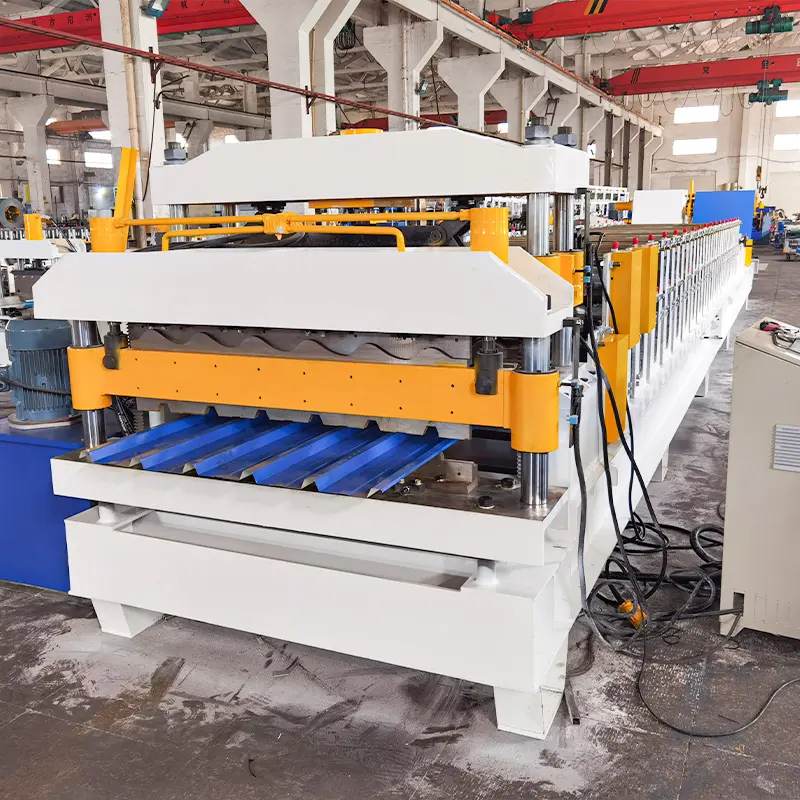
উপসংহার
ডাবল লেয়ার রোল ফর্মিং মেশিনগুলি ধাতু শীট উৎপাদনে বিপ্লব ঘটিয়েছে, বর্ধিত দক্ষতা, বহুমুখিতা এবং খরচ সাশ্রয় প্রদান করে। এই মেশিনগুলি প্রস্তুতকারকদের দুটি ভিন্ন প্রোফাইল একই সঙ্গে উৎপাদন করতে সক্ষম করে, উৎপাদন সময় এবং শ্রম খরচ হ্রাস করে উচ্চমানের মান বজায় রেখে। মেশিনের উপাদান, কার্যপ্রণালী, প্রয়োগ এবং নির্বাচনের সময় বিবেচ্য বিষয়গুলি বুঝে ব্যবসায় প্রতিষ্ঠানগুলি তাদের ধাতু শীট উৎপাদন ক্ষমতা উন্নয়নের জন্য সচেতন সিদ্ধান্ত গ্রহণ করতে পারে। প্রযুক্তির অগ্রগতির সঙ্গে ডাবল লেয়ার রোল ফর্মিংয়ের ভবিষ্যৎ উদ্ভাবন, অটোমেশন এবং টেকসইতার আরও বেশি সম্ভাবনা প্রদান করবে।
প্রায়শই জিজ্ঞাসিত প্রশ্ন (এফএকিউ)
প্রশ্ন ১: ডাবল লেয়ার রোল ফর্মিং মেশিনগুলি কি ভিন্ন মাত্রার প্রোফাইল উৎপাদন করতে পারে?
হ্যাঁ, ডাবল লেয়ার রোল ফর্মিং মেশিনগুলি বিভিন্ন মাত্রার প্রোফাইল উৎপাদনের জন্য সামঞ্জস্য করা যায়। মেশিনের রোলার অবস্থান, কাটিং দৈর্ঘ্য এবং অন্যান্য প্যারামিটারগুলি নির্দিষ্ট আকারের প্রয়োজনীয়তা পূরণের জন্য কাস্টমাইজ করা যায়।
প্রশ্ন ২: ডাবল লেয়ার রোল ফর্মিং মেশিনগুলি কি ছোট আকারের উৎপাদনের জন্য উপযুক্ত?
ডাবল লেয়ার রোল ফর্মিং মেশিনগুলি তাদের দক্ষতা এবং উৎপাদন ক্ষমতার কারণে সাধারণত মাঝারি থেকে বৃহৎ আকারের উৎপাদনের জন্য ব্যবহৃত হয়। তবে, যদি প্রোফাইল এবং পরিমাণ বিনিয়োগের যথার্থতা ন্যায্যতা প্রমাণ করে, তাহলে ছোট আকারের উৎপাদনের জন্যও এগুলি ব্যবহার করা যায়।
প্রশ্ন ৩: ভিন্ন প্রোফাইলের জন্য রোলার ডাই পরিবর্তন করতে কত সময় লাগে?
রোলার ডাই পরিবর্তনের সময় প্রোফাইলের জটিলতা এবং মেশিনের নকশার উপর নির্ভর করে। কিছু মেশিন দ্রুত টুলিং পরিবর্তনের সুবিধা প্রদান করে, যা অপারেটরদের তুলনামূলকভাবে সংক্ষিপ্ত সময়ে প্রোফাইলের মধ্যে স্যুইচ করতে সাহায্য করে, যেখানে অন্যগুলির জন্য আরও বিস্তৃত সামঞ্জস্য প্রয়োজন হতে পারে।
প্রশ্ন ৪: ডাবল লেয়ার রোল ফর্মিং মেশিনগুলি কি অধাতু উপাদানের সঙ্গে কাজ করতে পারে?
ডাবল লেয়ার রোল ফর্মিং মেশিনগুলি প্রধানত ধাতু শীট আকার দেওয়ার জন্য নকশা করা হয়েছে। প্লাস্টিক বা কম্পোজিটের মতো কিছু অধাতু উপাদানের জন্য এগুলি অভিযোজিত করা সম্ভব হলেও, এই ধরনের উপাদানের সঙ্গে মেশিনের সামঞ্জস্যতা এবং কর্মক্ষমতা পরিবর্তিত হতে পারে।
প্রশ্ন ৫: ডাবল লেয়ার রোল ফর্মিং মেশিনগুলি কি প্রোটোটাইপিংয়ের উদ্দেশ্যে উপযুক্ত?
ডাবল লেয়ার রোল ফর্মিং মেশিনগুলি সাধারণত টুলিং এবং সেটআপ খরচের কারণে প্রোটোটাইপিংয়ের পরিবর্তে ব্যাপক উৎপাদনের জন্য ব্যবহৃত হয়। তবে, যদি প্রোটোটাইপের পরিমাণ উল্লেখযোগ্য হয় বা প্রোফাইলগুলি বৃহত্তর উৎপাদনের অংশ হয়, তাহলে এগুলি খরচ-কার্যকর বিকল্প হিসেবে বিবেচিত হতে পারে।
মনে রাখবেন, আপনার নির্দিষ্ট প্রয়োজনের জন্য সঠিক ডাবল লেয়ার রোল ফর্মিং মেশিন নির্বাচন, নিয়মিত রক্ষণাবেক্ষণ নিশ্চিতকরণ এবং ক্ষেত্রের ভবিষ্যৎ অগ্রগতির সঙ্গে আপডেট থাকা আপনার ব্যবসায়কে প্রতিযোগিতামূলক রাখতে এবং ধাতু শীট উৎপাদন শিল্পের বিবর্তনশীল চাহিদা পূরণ করতে সাহায্য করবে।
Frequently Asked Questions (FAQ)
1) What profiles are best suited for Double Layer Roll Forming Machines?
- Corrugated roofing, trapezoidal wall panels, standing seam, tile sheets, and light purlin variants (e.g., mini C/Z). One cassette can run roof; the other can run wall to switch SKUs without a full tooling swap.
2) How much floor space can a double layer machine save versus two single lines?
- Typically 25–40% less footprint due to shared decoiler, leveler, electrical cabinet, and exit table, depending on coil width and cut-off configuration.
3) Can both layers run at the same time?
- Most double layer lines are “selectable layer” designs (one profile at a time) to share the drive and cut-off. True simultaneous dual-output versions exist but require twin drives, twin cut-offs, and more power.
4) What tolerances can be expected on modern double layer lines?
- Length tolerance ±0.8–1.5 mm/m and profile width ±0.3–0.6 mm with servo flying shear, encoder feedback, and well-designed pass tooling.
5) Which materials and coatings are commonly used?
- Pre-painted galvanized steel (PPGI), galvanized (GI) Z180–Z275, Aluzinc/Galvalume (AZ150–AZ200), and aluminum coils for coastal markets. Increasing use of zinc–magnesium (ZM) for longer corrosion life.
2025 Industry Trends
- AI-aided setup reduces changeover scrap and time between Layer A and Layer B by 30–50%.
- Quick-change cassettes and motorized roll positioning bring recipe swaps under 15–25 minutes.
- Energy-optimized drives and hydraulic standby cut energy intensity to 70–95 kWh/ton on best-in-class lines.
- Digital traceability (SCADA/MES) logs coil heat, coating class, and batch parameters to support EPDs.
- Demand shifts toward color-coated profiles and embossed finishes; tighter gloss/orange-peel controls via inline vision.
2025 Benchmarks for Double Layer Roll Forming Machines
| Metric | 2022 Typical | 2025 Best-in-class | Notes |
|---|---|---|---|
| Max line speed (m/min) | 20–35 | 45–70 | Profile-dependent; flying shear enables higher throughput |
| Changeover (Layer A ↔ B) (min) | 35–60 | 12–25 | With motorized roll positioning and recipe presets |
| Length tolerance (mm/m) | ±1.5–2.0 | ±0.8–1.0 | Encoder + servo cut; stable coil feed |
| Setup scrap (%) | 3–6 | 1–2 | AI vision and digital twins |
| Energy use (kWh/ton) | 110–150 | 70–95 | IE4/IE5 motors, regen drives, hydraulic standby |
| Coil utilization (%) | 96–97 | 98–99 | Optimized nesting and head/tail control |
Authoritative references:
- ISO 50001 Energy Management: https://www.iso.org/standard/69426.html
- EN 10169 organic coated steels (PPGI): https://standards.cen.eu
- World Steel Association coatings insights: https://worldsteel.org
- The Fabricator—roll forming process controls: https://www.thefabricator.com
Latest Research Cases
Case Study 1: AI-Guided Changeover on Double Layer Roofing/Wall Line (2025)
Background: A mid-size building products plant struggled with 45–60 min layer swaps and high first-off scrap after profile changes.
Solution: Implemented machine-vision edge tracking, torque signature monitoring on stands, and auto roll-gap presets; added servo flying shear with high-resolution encoder.
Results: Changeover time dropped to 18 minutes; setup scrap reduced from 4.2% to 1.5%; net output rose 22% at steady 58 m/min while holding ±1.0 mm length tolerance.
Case Study 2: ZM-Coated Coils for Coastal Trapezoidal Panels (2024)
Background: Coastal contractors reported premature edge corrosion on PPGI trapezoidal panels from GI coils.
Solution: Switched to ZM-coated substrate under EN 10169 paint systems; updated pass schedule to accommodate coating hardness and added inline coupon sampling for salt-spray correlation.
Results: ISO 9227 NSS tests showed >2× time to red rust vs GI; no reduction in line speed; claims rate on coastal projects decreased by 29% in 12 months.
Expert Opinions
- Dr. Laura Chen, Director, Cold-Formed Metals Research, AISI
Viewpoint: “Double layer roll forming machines deliver the best ROI when recipe control enforces dimensional tolerances and minimum bend radii matched to substrate and coating—especially with pre-painted coils.” - Marco De Santis, Product Manager, Gasparini SpA
Viewpoint: “Motorized roll positioning and quick-change cassettes are the single largest lever to cut downtime on double layer lines—bringing swaps under 20 minutes in most plants.” - Prof. Rafael Oliveira, Manufacturing Systems, University of Porto
Viewpoint: “Integrating SCADA/MES with coil traceability and energy metering enables EPD-ready datasets and exposes hidden losses—often unlocking 10–15% OEE improvement.”
Practical Tools/Resources
- EN 10169 organic coated steel guidance: https://standards.cen.eu
- World Steel Association—metallic coatings and corrosion: https://worldsteel.org
- ISO 50001 implementation guide: https://www.iso.org/standard/69426.html
- The Fabricator—roll forming pass design and QA: https://www.thefabricator.com
- Cognex/Keyence inline vision for profile and paint defect inspection: https://www.cognex.com | https://www.keyence.com
- AISI cold-formed steel resources: https://www.buildusingsteel.org
- Sample EPD programs for metal products: https://www.environdec.com
Last updated: 2025-10-20
Changelog: Added 5 targeted FAQs; introduced 2025 trends with benchmark statistics table; included two recent case studies; compiled expert viewpoints; added practical tools/resources with authoritative links
Next review date & triggers: 2026-04-15 or earlier if EN/ISO standards or coating guidance change, AI setup/vision benchmarks improve by >20%, or significant energy-efficiency technologies reach commercial adoption
